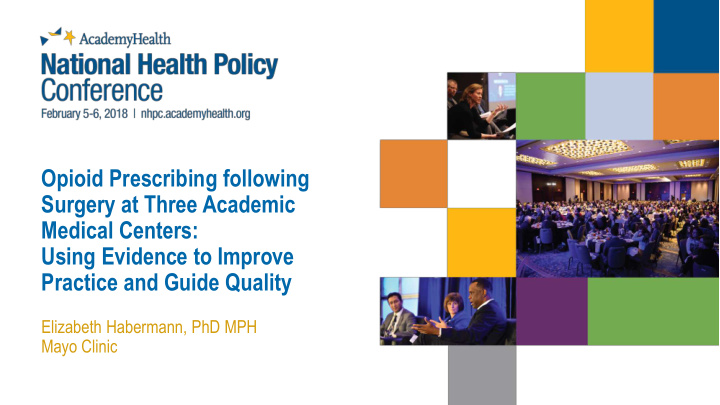



Opioid Prescribing following Surgery at Three Academic Medical Centers: Using Evidence to Improve Practice and Guide Quality Elizabeth Habermann, PhD MPH Mayo Clinic
Learning Objective: To understand how “one - size fits all” guidelines or legislation on surgery prescribing may not be appropriate
Overview: In response to the opioid epidemic, a number of state and federal policymakers either have implemented or are considering implementing guidelines or legislation to limit opioid prescribing following surgery However , these guidelines do not recognize variations in need by surgical procedure “Prescribe no more opioids than will be needed for initial tissue recovery following more extensive surgical procedures… “Limit the entire prescription to 200 MME (not 200 MME/day).” https://mn.gov/dhs/assets/2017-opip-overview_tcm1053-320120.pdf
The Evidence: ( Ann Surg 2017;266;564-573)
Procedure Groups G ENERAL S URGERY Methods 1. Lap Cholecystectomy 2. Lap Initial Inguinal Hernia Repair 3. Initial Inguinal Hernia Repair 4. Ventral Hernia Repair Adults undergoing 25 common elective procedures G ENERAL S URGICAL O NCOLOGY 5. Simple Mastectomy (2013-2015): 6. Breast Lumpectomy 7. Ileocecectomy 8. Laparoscopic LAR 9. VATS Wedge Resection O RTHOPEDIC 10. Total Shoulder 11. Total Hip 12. Knee Arthroscopic Meniscectomy 13. Total Knee 14. Rotator Cuff Repair S PINE 15. Lumbar Laminotomy 16. Lumbar Laminectomy Institutional ACS-NSQIP data + prescription data U ROLOGY /G YNECOLOGY 17. Lap Hysterectomy Calculated Oral Morphine Equivalents (OME) and 18. Vaginal Hysterectomy, 19. Lap Nephrectomy compared to State of Minnesota draft guidelines of 20. Lap Prostatectomy H EAD & N ECK max 200 OME following major surgery 21. Thyroid Lobectomy 22. Parathyroidectomy 23. Carotid Thromboendarterectomy 24. Parotid Gland Excision 25. Tonsillectomy
Opioid Naïve Patients 75.2% of patients (n=5,756)
OME Prescribed in Opioid Naïve Patients 200 1400 Prescribed Oral Morphine Equivalents (OME) 180 Standardized to 5mg Tabs of Oxycodone 1200 160 140 80.9% of opioid naïve patients 1000 received > 200 OME 120 800 (This varied by procedure) 100 600 80 60 400 40 200 20 0 0 Procedure
The Evidence: But how much do surgical patients use? Patient survey data from our institution: Median amounts used varied by procedure, from 0 to 400 OME Data to be presented at the American Surgical Association in April 2018 Utilization data and patient and procedural predictors of high or low opioid consumption will inform institutional prescribing guidelines. Data on patient consumption and pain control is what should drive policy, not a one-size-fits all limit
Health Policy Implications: Variations by surgical procedure Amount of opioids prescribed at discharge Amount of opioids consumed by surgical patients need for more procedure-specific policy or guidance Hydrocodone (Norco) 5 mg tablets Codeine (Tylenol #3) Oxycodone Procedure 30 mg tablets 5 mg tablets Tramadol 50 mg tablets Laparoscopic Cholecystectomy 15 10 Laparoscopic Appendectomy 15 10 Inguinal/Femoral Hernia Repair 15 10 (open/laparoscopic) Open Incisional Hernia Repair 40 25 Laparoscopic Colectomy 35 25 Open Colectomy 40 25 Hysterectomy Vaginal 20 15 Laparoscopic & Robotic 30 20 https://opioidprescribing.info/ Abdominal 40 25 Wide Local Excision ± Sentinel Lymph 30 20 Node Biopsy Simple Mastectomy ± Sentinel Lymph 30 20 Node Biopsy Lumpectomy ± Sentinel Lymph Node 15 10 Biopsy Breast Biopsy or Sentinel Lymph Node 15 10 Biopsy
Why This Matters: There is wide variation and over prescription of opioids to surgical patients State and federal policies have been developed to address overprescription But may not be appropriate for all surgical procedures Institutionally, we have used these data to develop specialty- and procedure-specific guidelines Future policy should consider these differences Next steps: Disseminate evidence to policy makers to reflect procedural and patient variation in appropriate opioid prescriptions Individualized medicine and pharmacogenomics Continued refinement of best practices and policy
Recommend
More recommend